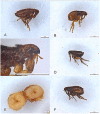Flea parasitism in wild mammals in the metropolitan region of Sorocaba, São Paulo, Brazil
- PMID: 38149030
- PMCID: PMC10750502
- DOI: 10.29374/2527-2179.bjvm003523
Flea parasitism in wild mammals in the metropolitan region of Sorocaba, São Paulo, Brazil
Abstract
Fleas are eurixenous ectoparasites that can parasitize different species of warm-blooded animals, including humans, with the possibility of causing irritation and blood spoliation. They are vectors responsible for the transmission of numerous pathogens and have a wide geographical distribution, more frequently in warm regions. Domestic animals (dogs and cats) are preferred hosts, but parasitism can also occur in wild hosts, with a greater variety of parasitic species and strong interaction between these siphonapters and their hosts. During the period from January 2021 to June 2023, flea specimens were collected from wild animals coming from the metropolitan region of Sorocaba, São Paulo. Some of these animals were animals from the zoo's own stock, which were diagnosed with parasitism during routine examinations and others were rescued from the natural environment and sent to the zoo. The flea specimens collected were packed in alcohol 700 GL and sent for microscopic diagnosis. Four groups were diagnosed at the specific level: Ctenocephalides felis, Rhopalopsyllus lutzi, R. lugrubis and Tunga penetrans, and two groups as unidentified species, belonging to the genera Rhopalopsyllus and Polygenis. The parasitized animals were all mammals, belonging to eleven different species, distributed in the Orders Carnivora, Didelphimorphia, Rodentia and Cingulata. Studies on the parasitofauna of wild animals contribute to a greater knowledge about the distribution of parasitic agents and their relationships with the host species.
As pulgas são ectoparasitos eurixenos que podem parasitar diferentes espécies de animais de sangue quente, incluindo seres humanos, com possibilidade de causar irritação e espoliação sanguínea. São vetores responsáveis pela transmissão de inúmeros patógenos e apresentam ampla distribuição geográfica, com maior frequência em regiões quentes. Os animais domésticos (cães e gatos) são hospedeiros preferenciais, mas o parasitismo pode ocorrer também em hospedeiros selvagens, com maior variedade de espécies parasitas e forte interação entre esses sifonápteros e seus hospedeiros. Durante o período de janeiro de 2021 a junho de 2023, espécimes de pulgas foram coletados de animais selvagens provenientes da região metropolitana de Sorocaba, São Paulo. Alguns destes animais eram animais do plantel do próprio zoológico, que foram diagnosticados com o parasitismo durante exames de rotina e outros foram resgatados do ambiente natural e encaminhados ao zoológico. Os espécimes de pulgas coletadas foram acondicionados em álcool 700 GL e enviados para diagnóstico microscópico. Foram diagnosticados quatro grupos a nível específico: Ctenocephalides felis, Rhopalopsyllus lutzi, R. lugrubis e Tunga penetrans, e dois grupos como espécies não identificadas, pertencentes aos gêneros Rhopalopsyllus e Polygenis. Os animais parasitados eram todos mamíferos, pertencentes a onze espécies diferentes, distribuídas nas Ordens Carnivora, Didelphimorphia, Rodentia e Cingulata. Estudos sobre a parasitofauna de animais selvagens contribuem para um maior conhecimento sobre a distribuição de agentes parasitários e suas relações com as espécies hospedeiras.
Keywords: ectoparasite; siphonaptera; zoological.
Conflict of interest statement
Conflict of interests: RHFT, ALMC, CRRG, FNM, MAM, SFS, RVM, MAB, BFL, CAMS, LAB. No conflict of interest
Figures
References
-
- Almeida C. N. H., Araújo A. S., Campos F. S., Lobato Z. I. P., Gennari S. M., Marvulo M. F. V., Silva J. C. R., Talamoni S. A. Wild canids, domestic dogs and their pathogens in Southeast Brazil: Disease threats for canid conservation. Biodiversity and Conservation. 2010;19(12):3513–3524. doi: 10.1007/s10531-010-9911-0. - DOI - PMC - PubMed
-
- Antunes J. M. A., Demoner L. D. C., Martins I. V., Zanini M. S., Deps P. D., Pujol-luz J. R. Registro de Dasypus novemcinctus (Mammalia: Xenarthra) parasitado por Tunga terasma (Siphonaptera: Tungidae) em Alegre, Estado do Espírito Santo, Brasil. Revista Brasileira de Parasitologia Veterinária. 2006;15(4):206–207. - PubMed
-
- Barros-Battesti D. M., Arzua M. Geographical distribution by biomes of some Marsupial Siphonaptera from the state of Paraná, Brazil. Memorias do Instituto Oswaldo Cruz. 1997;92(4):485–486. doi: 10.1590/S0074-02761997000400007. - DOI
LinkOut - more resources
Full Text Sources
Miscellaneous

